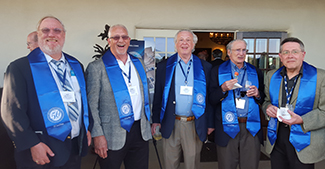The Physics “Class of 1966” Finds Cohesion in Diaspora
May 13, 2022 | By Jay Dratler, Jr.
 50th reunion reception at the chancellor’s residence (L-R): Jack Gaffey, Joe Smith, Mark Granoff, Jay Dratler and George Morales. (cr: Jack Gaffey)
50th reunion reception at the chancellor’s residence (L-R): Jack Gaffey, Joe Smith, Mark Granoff, Jay Dratler and George Morales. (cr: Jack Gaffey)
It all started in Mumbai, India in December 2012. I was visiting Chetan Mehta in his home near the Mumbai campus of the Indian Institute of Technology (IIT). Sitting around Chetan’s living room table, we reminisced about our halcyon days studying physics in graduate school at UC San Diego.
The result was a “Mumbai (Physics) Manifesto,” proposing a class reunion a half century since we were together on campus. The manifesto was sent out via email to the rest of the class.
With the help of the development team in the Division of Physical Sciences, the reunion took place almost four years later in the fall of 2016. We were able to visit classes and laboratories, discuss current physics research, and attend a reception, hosted by Chancellor Pradeep K. Khosla at his home. Most importantly, we were able to reconnect with old friends. On the last day we patched Chetan in by video from Mumbai.
To this day, with some attrition, the class remains cohesive. With the onset of the pandemic, Dave Baxter initiated monthly Zoom meetings as a way to stay connected. The Zoom group, self-dubbed “the Staid Lions,” continues to meet. We are told this cohesion is unusual.
Like most doctoral classes, we dispersed to the four winds after graduation. In our case, the dispersion was not only geographic, but professional. Most of us graduated in the early seventies when federal support for scientific research was plunging in a reassessment of national priorities. So many of us took career paths that were nontraditional for physics Ph.D.s.
Some of us ended up professing physics: George Blumenthal at UC Santa Cruz (where he later became chancellor); Bill Dallas jointly at the Department of Physics and the School of Medicine at the University of Arizona; Jack Gunion at UC Davis; John Huber at Tufts University and the University of Virginia; Pradeep Kumar at the University of Florida; Chetan Mehta at the University of Bombay (where he met his wife Mamta), then at Oil & Natural Gas Corporation Ltd, and finally at IIT Mumbai; Keith Stowe at California State University at San Luis Obispo; Tom Witten at the University of Chicago; and Amitabha “Amit” Bagchi at the University of Maryland and then AT&T Bell Laboratories.
A few joined government laboratories: Bruce Brown at Fermilab; Jack Gaffey at the University of Maryland and NASA Goddard Space Flight Center; Alan Glasser at Princeton Plasma Physics Laboratory, Los Alamos National Laboratory, and Fusion Theory and Computation, Inc.; Sheryl Glasser at Los Alamos National Laboratory and the Centers for Disease Control and Prevention; and Prabhakar Tripathi at a laboratory on the west coast.
 Department of Physics students, 1966-67
Department of Physics students, 1966-67
Several got law degrees and went on to practice or teach law and/or went into business: Jay Dratler, Jr., became a business lawyer in the Bay Area and a professor of law at the Universities of Hawaii and Akron; Ron Grubman was initially a patent lawyer and eventually CEO of Blue Sky Research, Inc.; and Joe Smith became a patent lawyer who was later involved in medical administration and in financing the biotech industry and genomics revolution.
Many of us went into other fields and businesses related to physics. Dave Baxter went into computer and software engineering at several companies, before finally retiring from IBM. Bill Carmody got a doctorate in economics and was a professor of economics at the Virginia Polytechnic Institute and State University and later, UC San Diego. Mark Granoff got a medical degree, practiced medicine and became a hospital administrator. Bob LaQuay worked at the Princeton Plasma Physics Laboratory, returned to La Jolla to form several small companies, and now lives in the Philippines and builds small boats. Dan Pinkel joined the biomedical group of Lawrence Livermore National Laboratory, and later the faculty of the Cancer Center at UC San Francisco. Robert Poe (an honorary but not chronological member of our group) went into digital imaging for a start-up company eventually acquired by Eastman Kodak. Dave Stolfa became an integrated-circuit engineer working for Motorola, National Semiconductor and Intel.
What motivated this geographic and professional diaspora? Was it the times? Was it the collapse of federal support for research in physics? Was it the political and cultural revolutions during the late sixties and early seventies, while we were in grad school? Was it the newness of UC San Diego itself, then only two years into its metamorphosis from a specialized graduate research center to a full university, making use of the former marine base that had once been Camp Matthews? Was it the nearness of the beaches, sun and surf, and Mexico, which enhanced our leisure time and sparked our imaginations?
Whatever the reason, and despite our diaspora—or maybe because of it— the Physics Class of 1966 (we count our reunions from matriculation, not graduation, as we all got our Ph.D.s at different times) still feels the bonds of affection and nostalgia after half a century and counting. Planning for the next reunion, perhaps the sixtieth, is already under way.
